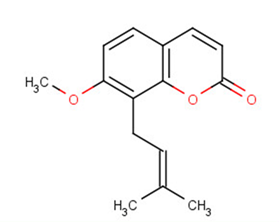
Osthole
CAS No. 484-12-8
Osthole( Osthole | Osthol | Ostole | Ostol )
Catalog No. M18626 CAS No. 484-12-8
Osthole, a potential inhibitor of histamine H1 receptor, has been shown to stimulate osteoblast proliferation and differentiation.
Purity : >98% (HPLC)
 COA
COA
 Datasheet
Datasheet
 HNMR
HNMR
 HPLC
HPLC
 MSDS
MSDS
 Handing Instructions
Handing Instructions
| Size | Price / USD | Stock | Quantity |
| 1G | 87 | In Stock |


|
Biological Information
-
Product NameOsthole
-
NoteResearch use only, not for human use.
-
Brief DescriptionOsthole, a potential inhibitor of histamine H1 receptor, has been shown to stimulate osteoblast proliferation and differentiation.
-
DescriptionOsthole is a calcium channel blocker, found in plants such as Cnidium monnieri, Angelica archangelica and Angelica pubescens. Osthole regulates inflammatory mediator expression through modulating NF-kappaB, mitogen-activated protein kinases, protein kinase C, and reactive oxygen species.
-
In Vitro——
-
In Vivo——
-
SynonymsOsthole | Osthol | Ostole | Ostol
-
PathwayOthers
-
TargetOther Targets
-
RecptorH1 receptor
-
Research AreaOthers-Field
-
Indication——
Chemical Information
-
CAS Number484-12-8
-
Formula Weight244.29
-
Molecular FormulaC15H16O3
-
Purity>98% (HPLC)
-
SolubilityDMSO : 125 mg/mL 511.69 mM
-
SMILESCC(=CCc1c(ccc2c1oc(=O)cc2)OC)C
-
Chemical Name7-methoxy-8-(3-methylbut-2-en-1-yl)-2H-chromen-2-one
Shipping & Storage Information
-
Storage(-20℃)
-
ShippingWith Ice Pack
-
Stability≥ 2 years
Reference
1. Ko FN, et al. Thromb Haemost, 1989, 62(3), 996-999.
molnova catalog



related products
-
Benodanil
BENODANIL is a kind of fungicide.
-
CCTA-1523
CCTA-1523 is an efflux function of ABCG2 inhibitor. CCTA-1523 selectively reverses ABCG2-mediated MDR in cancer cells.
-
zerumbone
Zerumbone is a natural monocyclic sesquiterpene first isolated from rhizomes of the wild ginger Z. zerumbet.It has also been shown to have anti-oxidant and anti-inflammatory activities contributing to immunomodulatory and hepatoprotective effects.



 Cart
Cart
 sales@molnova.com
sales@molnova.com


